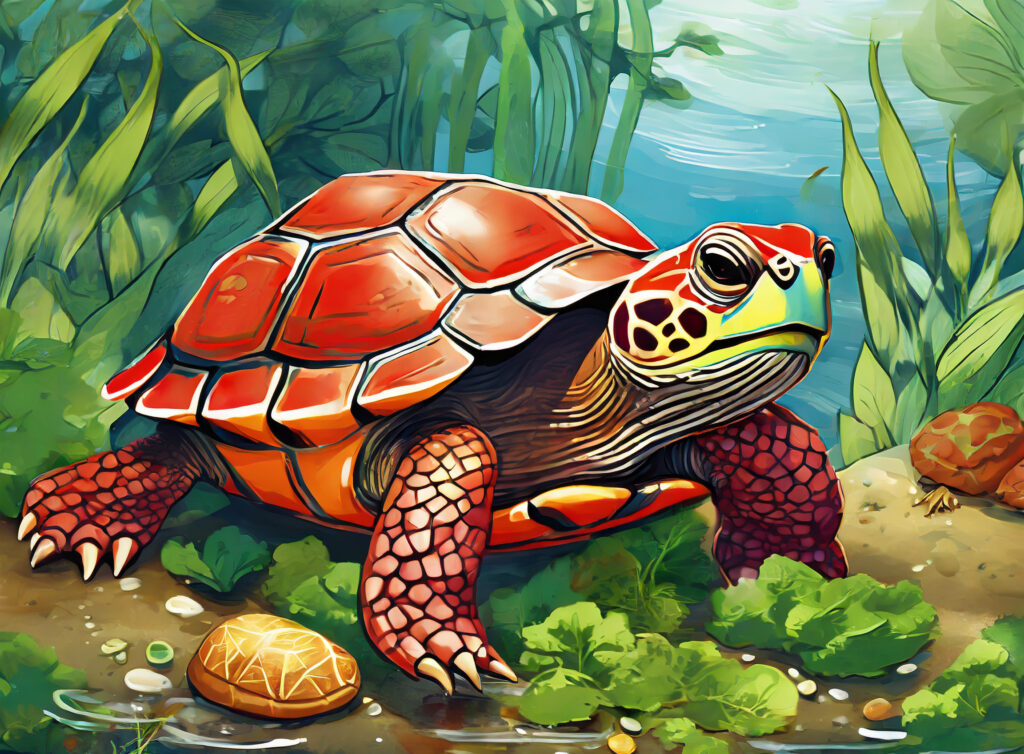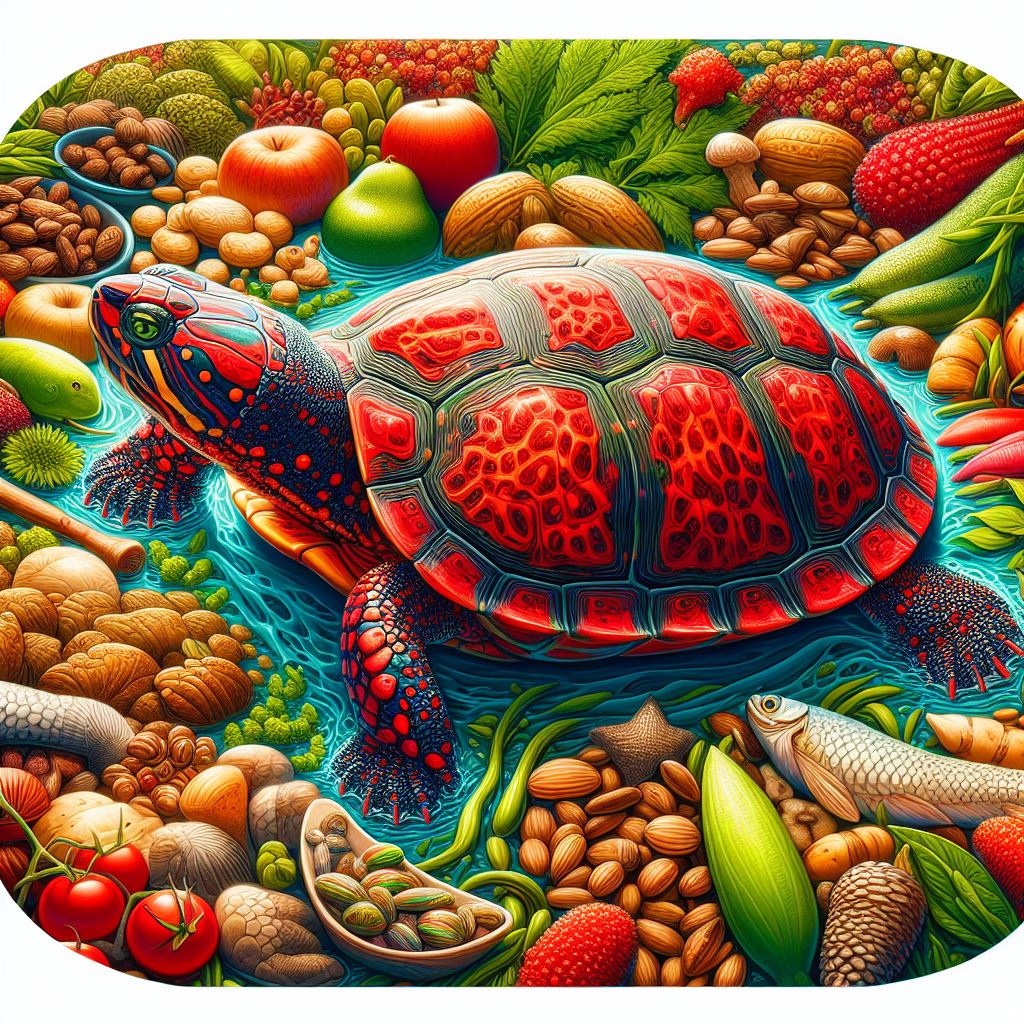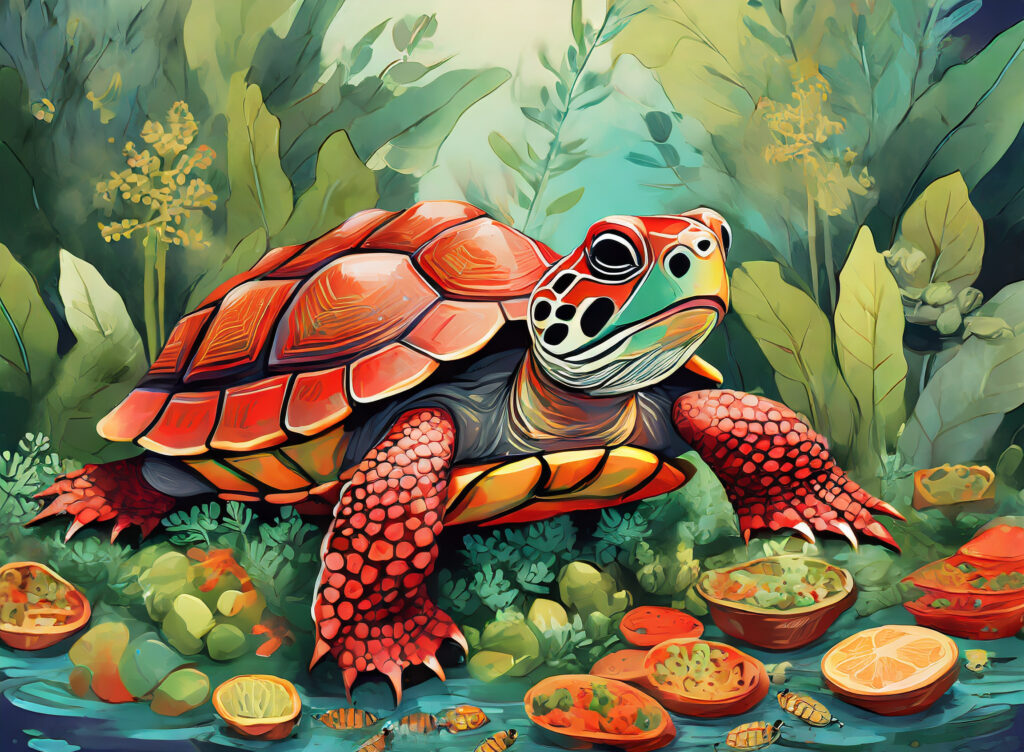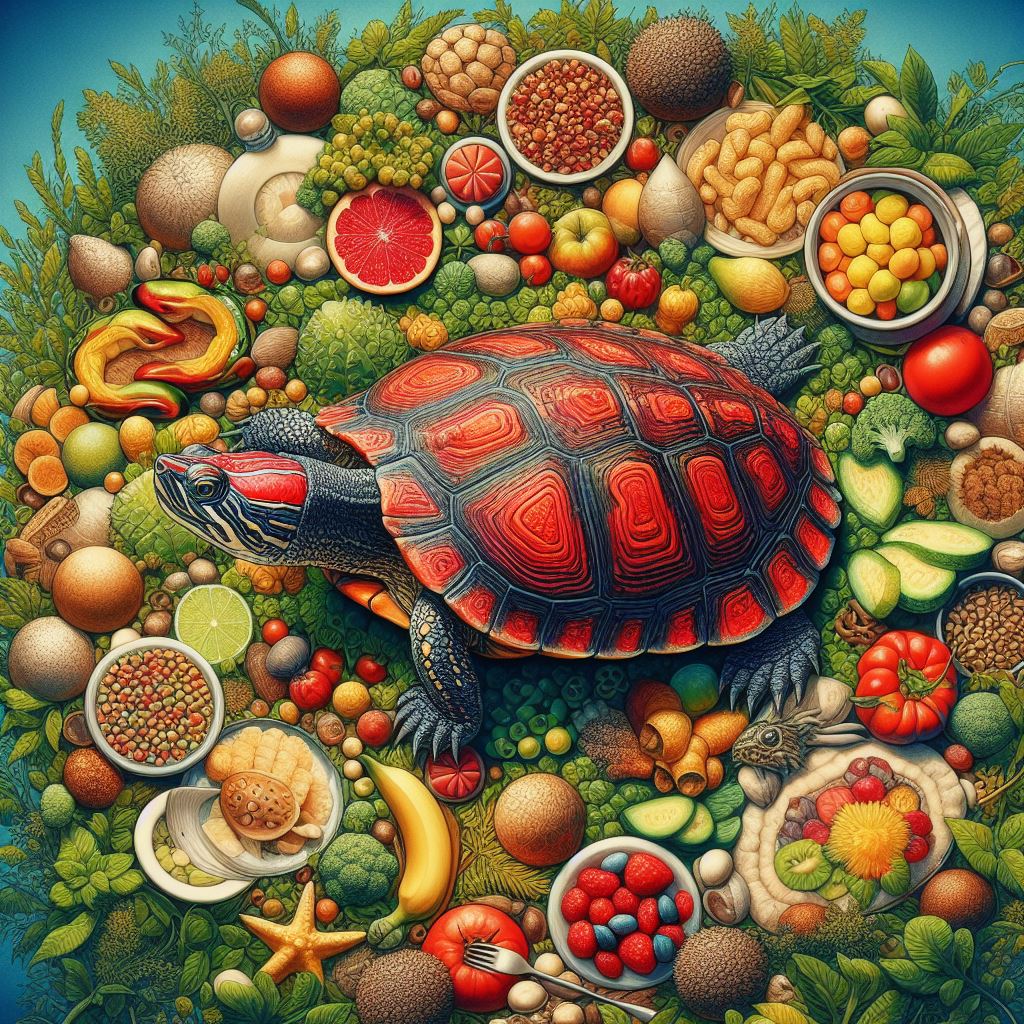Obtaining the right diet is crucial for the health and well-being of red painted turtles. These fascinating creatures are omnivores, which means they consume a variety of foods. In the wild, they primarily feed on aquatic plants, insects, small fish, and crustaceans. It’s important to note that red painted turtles are prone to obesity if overfed, leading to various health issues.
In captivity, their diet should consist of a mix of commercial turtle pellets, live or frozen insects, leafy greens, and the occasional feeder fish. Additionally, feeding red painted turtles too much protein can lead to shell deformities and kidney issues. It’s crucial to strike a balance in their diet to keep them healthy and thriving. Providing a well-rounded and diverse diet is essential for the overall health and longevity of these captivating creatures.
Key Takeaways:
- Red-painted turtles primarily eat aquatic plants such as duckweed, water lettuce, and water ferns as a major part of their diet.
- They also consume small aquatic invertebrates such as snails, insects, crayfish, and small fish to supplement their plant-based diet.
- Proper nutrition for red-painted turtles also includes providing them with commercially available turtle pellets and occasional fruits such as berries and melons as treats.
Natural Habitat and Behavior
Some red painted turtles are native to the eastern United States and are commonly found in freshwater bodies such as ponds, lakes, and slow-moving rivers. They prefer shallow, clear water with plenty of vegetation and basking spots. Red painted turtles are known for their shy and docile nature, often basking on rocks or logs in the sun.

Distribution of Red Painted Turtles
Red painted turtles are primarily found in the eastern United States, particularly in states such as Virginia, North Carolina, and Florida. They are also found in parts of Canada, including Ontario and Quebec. These turtles prefer habitats with slow-moving freshwater and ample vegetation, allowing them to find a variety of food sources.
Behavioral Patterns Related to Feeding
Red painted turtles are omnivores and have a diverse diet that includes aquatic plants, insects, small fish, and algae. They are known to be opportunistic feeders, foraging for food both in the water and on land. Their feeding behavior is influenced by the availability of food in their natural habitat, with their keen sense of smell and sight allowing them to locate prey.
Diet of the Red Painted Turtle
Even though red painted turtles are known as omnivores, their diet largely consists of plant-based food sources along with some animal-based ones. Their diet primarily consists of aquatic plants, fruits, vegetables, and small insects. It’s important to understand the different food sources that red painted turtles consume in order to provide adequate nutrition if they are being kept as pets.
Plant-Based Food Sources
Red painted turtles consume a variety of plant-based food sources, including aquatic plants such as duckweed, water lettuce, and water hyacinth. They also enjoy eating fruits and vegetables such as strawberries, blueberries, raspberries, lettuce, and kale. Providing a variety of plant-based food sources ensures that they receive the necessary vitamins and nutrients for their overall health and well-being.
Animal-Based Food Sources
In addition to plant-based food sources, red painted turtles also consume some animal-based food sources. They are known to eat small insects such as mealworms, crickets, and small fish. It’s important to note that while they do consume animal-based food, it should only make up a small part of their diet. Overfeeding them with animal-based food sources can lead to health issues such as obesity and shell deformities.
It’s important to maintain a balanced diet for red painted turtles, offering a combination of both plant-based and animal-based food sources. Additionally, providing them with a proper habitat and environmental enrichment can contribute to their overall well-being.
Feeding Habits Across Life Stages
Your red-eared slider turtle’s feeding habits will change as he grows and matures. Understanding these changes is crucial to providing proper care and nutrition for your pet throughout his life.

Dietary Requirements of Hatchlings
When red-eared slider turtles are hatchlings, they have very specific dietary needs. They require a diet high in protein to support their rapid growth and development. At this stage, they should be fed a combination of commercial turtle pellets, small live insects, and occasional small fish or shrimp. It is important to provide a varied diet to ensure they receive all the essential nutrients they need for healthy growth. Additionally, it’s crucial to monitor their calcium intake and provide appropriate supplementation to prevent issues like shell deformities.
Changes in Diet as Turtles Mature
As red-eared sliders mature into adults, their dietary requirements change significantly. While they still need a stable source of protein, their diet should also include a variety of dark, leafy greens, and vegetables. These should make up the majority of their diet, supplemented with occasional proteins such as fish and insects. It’s essential to continue providing sources of calcium to maintain their shell and bone health. It’s also important to note that overfeeding and a lack of variety in the diet can lead to obesity and other health issues in adult turtles.
Human Impact on Red Painted Turtle Diet
After decades of human impact on the environment, the diet of the red painted turtle has been significantly affected. Pollution and habitat destruction have led to changes in the availability and quality of their food sources. Understanding the impact of human activity is crucial for the conservation and preservation of the red painted turtle diet.
Effects of Pollution on Food Sources
Pollution, particularly in water bodies where red painted turtles reside, has had detrimental effects on their food sources. Contaminants such as heavy metals, pesticides, and plastics have found their way into the aquatic ecosystems, affecting the quality of the plants and invertebrates that the turtles feed on. This has led to a decline in the nutritional value of their diet, impacting their overall health and reproductive success. Efforts to reduce pollution in their habitats are essential for ensuring the availability of nutritious food for red painted turtles.
Conservation Efforts and Diet Preservation
Conservation efforts play a crucial role in preserving the red painted turtle diet. Restoring and protecting their natural habitats is essential for maintaining a diverse and abundant food supply. This includes conserving wetlands, rivers, and lakes, and controlling pollution to ensure the availability of food sources for the red painted turtles. Additionally, promoting awareness and education about the importance of preserving their diet can lead to positive changes in human behavior and the protection of turtle habitats.

What Do Red-Painted Turtles Eat
Now that it is clear what red-painted turtles eat, it is important to ensure that their diet is well-balanced. Their omnivorous nature makes it important to provide a mix of plant-based and protein-rich foods. Leafy greens, fruits, insects, and small fish make up the ideal diet for these turtles. It is imperative to monitor their intake and ensure that they are getting all the necessary nutrients to thrive and live a healthy life. By providing a varied diet, one can ensure that these beautiful creatures remain healthy and happy in their habitat.
FAQ
Q: What do red painted turtles eat?
A: Red painted turtles are omnivores and typically eat a diet consisting of aquatic plants, insects, small fish, and crustaceans. It is important to provide a varied diet to ensure they receive the necessary nutrients for overall health and well-being.
Q: Can red painted turtles eat fruits and vegetables?
A: Yes, red painted turtles can eat certain fruits and vegetables as part of their diet. Some examples include leafy greens like kale and spinach, as well as fruits such as strawberries and blueberries. However, these should be offered in moderation and should not be the primary source of nutrition.
Q: How often should red painted turtles be fed?
A: Red painted turtles should be fed daily when they are young, and every other day as they reach adulthood. It is important to monitor their weight and adjust their feeding schedule accordingly to prevent obesity or malnutrition. Additionally, providing a balance between plant and protein-based foods is essential for their overall health.






Leave a Reply